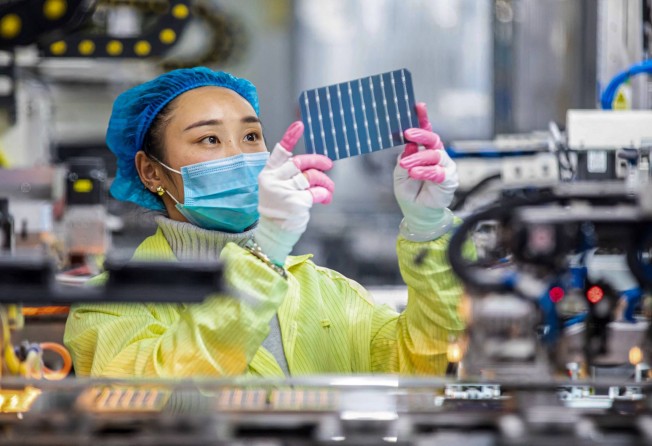
China’s solar panel giants ramp up polysilicon capacity to fix supply chain shortages
- After years of falling prices, the cost of the raw material skyrocketed last year as a jump in demand overwhelmed existing manufacturing capacity
- China’s top producers have opened new plants with combined capacity of 160,000 tons a year, adding to the current global capacity of about 620,000 tons

The supply chain snarl that tripled the price of a key raw material for solar panels is about to get fixed, clearing the way for a renewed boom in the use of the clean energy technology.
China is spending billions on new factories to produce polysilicon, used to make photovoltaic cells for solar panels. Global capacity has already been boosted by more than a quarter in the past two months, and it will double by early next year. That should help rein in prices of the material after surging costs slowed the pace of new renewables projects.
As component shortages to a squeeze on shipping drive up prices for everything from natural gas to beef, polysilicon is an example of how some supply woes is likely to prove transitory.
It also shows how China is using its industrial heft to ensure its continued dominance in solar, a sector that is key to fending off the worst impacts of climate change.
The multibillion expansion of polysilicon capacity will “help to remove a key bottleneck to the solar value chain,” said Tony Fei, an analyst with BOCI Research. “We expect solar panel supply to be vastly boosted in the coming years with declining prices, contributing to decarbonisation of the global energy mix.”
Solar panels are made from ingots of ultra-conductive polysilicon that are sliced into razor-thin wafers, wired up into cells and then assembled into the equipment that is mounted on rooftops or across vast energy farms.
After years of prices falling as companies opened newer and more efficient polysilicon plants, the raw material skyrocketed last year as a jump in demand overwhelmed existing manufacturing capacity. By late 2021, polysilicon was trading at a 10-year high.
Prices have already come off 17 per cent since November after Tongwei Co, Daqo New Energy and GCL-Poly Energy Energy Holdings – among the key global producers – opened new plants or lines with combined capacity of 160,000 tons a year, adding to a current global fleet of about 620,000 tons, according to BloombergNEF data.
Another 550,000 tons of capacity is under construction, most of which will be online by the end of this year.
“Polysilicon prices will remain elevated in the first half of 2022 and then nosedive to a historic low in 2023,” said Dennis Ip, an analyst with Daiwa Capital Markets. In turn, that will drive down costs of solar modules and deliver strong growth in installations, he said.
Beyond the projects already under construction, another 1.5 million tons of new capacity has been announced, including more than 850,000 tons last month alone, according to BloombergNEF data and company filings.
One reason for that December surge was China’s decision to loosen energy-consumption rules for renewable power-related materials, according to BOCI’s Fei.
Several recently announced projects have also vowed to use wind and solar to power their polysilicon production lines, which will ensure they avoid scrutiny from government watchdogs investigating high-polluting industries.

Many of the new projects are also being located outside Xinjiang, home to nearly half of existing global production. That factor has put the solar industry in the crosshairs of global trade wars, as governments including the US bar products from the region because of accusations of forced labour and other efforts to suppress the predominately Muslim Uygur minority. China’s government has repeatedly denied those allegations.
Fixing polysilicon shortages is key for the solar industry because it is the most difficult step in the supply chain in which to add capacity. New plants can take 18 to 24 months to come online, followed by a lengthy ramp-up process, compared to under a year for less complicated materials or manufacturing processes.
“Polysilicon is the one step that requires a long time to build capacity,” said Yali Jiang, an analyst with BloombergNEF in Hong Kong. “Building wafer, cell and module plants is very fast nowadays.”
By the end of this year, solar companies will be able to produce enough polysilicon to allow for more than 500 gigawatts of capacity to be installed annually, which compares to a total of about 144 gigawatts installed globally in 2020.
BloombergNEF estimates about 455 gigawatts need to be added every year through 2030 for the world to be on pace to avoid the worst effects of climate change.
“We’ve seen several countries where projects are on hold or where they’re not going forward because of high prices,” said Johannes Bernreuter, head of polysilicon market intelligence firm Bernreuter Research.
“Once the polysilicon bottleneck is removed and prices come down again, it will incentivise even more dynamic demand.”